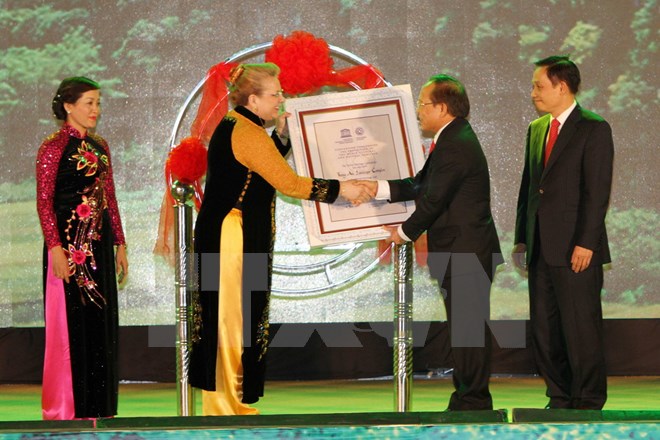The Trang An complex in the northern province of Ninh Binh received a certificate from UNESCO certificate officially recognising it as a combined natural and cultural World Heritage site at a grand ceremony on January 23.

Addressing the ceremony, Deputy Prime Minister Vu Duc Dam said the recognition of many sites and traditions in Viet Nam as world heritages reflects the international community's acknowledgement of the nation’s priceless treasures.
Trang An makes all Vietnamese proud of their nation's heroic history, he said, noting that Trang An was a resistance base against the Yuan Mongolian invaders and a base for Buddhism.
Katherine Muller-Marin, Head of the UNESCO office in Viet Nam, said that the values of Trang An will be protected under the World Heritage Convention.
Before making the UNESCO list, Trang An was already a famous tourism complex, she said. With the new title, tourism development will be cherished by the local government and local community, she said.
Trang An complex has many stories about how ancient communities adapted to environmental and climate changes and "we want to hear these stories," she added.
UNESCO acknowledges efforts by Vietnamese Government in planning and preserving this complex, she said.
The Chairman of Ninh Binh province's People's Committee, Dinh Van Dien, said it was a special day for Ninh Binh.
"The province will make plans and submit them to the Prime Minister, providing a foundation for regulations to protect the heritage.
"We will focus on training human resources, study cultural and historical values, and encourage tourists to join hands in protecting the environment," he said.
A unanimous decision taken at the 38th session of UNESCO's World Heritage Committee in Doha on June 23 last year made the complex the first combined natural and cultural site of Viet Nam and Southeast Asia to get the coveted recognition.
The complex met UNESCO's three main criteria on cultural, aesthetic and geographical values with scientists finding a lot of evidence of interaction between early human beings and the environment, and of people's adaptation to fierce climate changes.
Aesthetically, the complex offers magnificent scenic views with karst mountains rising over still-water streams. The mountains host many mysterious caves and holy pagodas.
In terms of geographical and geomorphologic values, the complex is evidence of the latest development period of karst in a humid tropical climate.
In UNESCO's words, "Trang An is a resplendent complex of limestone karst peaks which are permeated with valleys, including submerged ones, and surrounded by steep, almost vertical cliffs", nestling on the southern shore of the Red River Delta.
Archaeological traces of human activity dating back thousands of years have been found within the complex.
The Trang An complex boasts several nationally recognised sites like the Trang An ecotourism site and Hoa Lu, Viet Nam's capital in the 10th and 11th centuries.
The area also has many other temples, pagodas, paddy fields, villages, and other sacred sites.
It is home to around 500 flora species, 73 species of birds and 41 species of other animals, and has a diverse ecosystem with unique geological characteristics.
Last year, the site received nearly 4.8 million tourists.